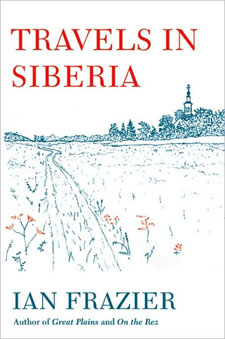Read This: Travels in Siberia
 I’m headed to the 92nd Street Y tonight to see a discussion between two of my favorite New Yorker writers, Ian Frazier and John McPhee, where one of the main topics of discussion is sure to be Frazier’s new book, Travels in Siberia. I am only one-fifth of the way through it as I write this, but I’m absolutely loving it—this is a perfect example of an author giving himself over to his passion for a subject and letting it take him where it will. In this case, there’s Frazier’s passion for the “real,” geographical and natural Siberia, but that’s just the beginning; just over 100 pages in, and there have also been historical, cultural, social, and literary dimensions to his enthusiasm as well. The descriptions are exquisite, but infused with a masterfully deadpan humor. One of my favorite lines so far: “To an unromantic eye, [Nome, Alaska] in certain seasons may look like an expanse of mud with pieces of rusted iron sticking out of it.”
I’m headed to the 92nd Street Y tonight to see a discussion between two of my favorite New Yorker writers, Ian Frazier and John McPhee, where one of the main topics of discussion is sure to be Frazier’s new book, Travels in Siberia. I am only one-fifth of the way through it as I write this, but I’m absolutely loving it—this is a perfect example of an author giving himself over to his passion for a subject and letting it take him where it will. In this case, there’s Frazier’s passion for the “real,” geographical and natural Siberia, but that’s just the beginning; just over 100 pages in, and there have also been historical, cultural, social, and literary dimensions to his enthusiasm as well. The descriptions are exquisite, but infused with a masterfully deadpan humor. One of my favorite lines so far: “To an unromantic eye, [Nome, Alaska] in certain seasons may look like an expanse of mud with pieces of rusted iron sticking out of it.”
And it is entirely to Frazier’s credit that he can still make you want to visit that place.
There’s a section of photographs in the middle of the book, but I’m more enchanted by the line drawings Frazier has dropped into the text at irregular intervals—you can get a feeling for his style with that cover illustration. But I’m even more enamored of his prose, which manages to be both intimate and comprehensive. As I say, he’s given himself over to his passion for the subject, and, for the reader, he serves as a personal guide, walking us through the vast terrain and making sure our attention never flags. I don’t want to spoil very many of the pleasures this book has in store for you by giving them away early, and I still have plenty of them to discover for myself, but I will tell you that Frazier can make you care as much about a 19th-century American travel writer, or the long span of the Mongol Empire, as you will about his own camping trip with crabby American tourists. Travels in Siberia is a warm, thoughtful book that has me very much looking forward to hearing more from the man who wrote it.
13 December 2010 | read this |
Paul Murray: Filling in the School Novel’s Margins

If only the café down the street from Paul Murray’s hotel had donuts—our interview could have had that extra little touch of Skippy Dies resonance. No such luck, but once I’ve brought a latte and a tea back to our table, we’re able to plunge into a wonderful conversation. I began by observing that if you read his first novel, An Evening of Long Goodbyes, as an answer to the question “How do you pull off Wodehouse comedy in the 21st century?”, Skippy Dies could be seen as an answer to, “OK, then, how do you do the boarding school novel in the 21st century?” But of course Murray isn’t systematically working his way through the sub-genres of the 20th-century British novel. “I just found the environment of the school very enjoyable to write about,” he explained. “However many characters you want… the setting brings everything together.”
The novel had its origins in a short story about a biology teacher and one of his students, who had turned in a paper about “sea enemies;” when that story passed the 60-page mark, however, he tried to figure out how to scale it back. Then his brother suggested that maybe the answer was to build it out even further, into a novel, and Murray remembered a fragment of a story he’d written years earlier, about two schoolboys sitting in a diner having a donut-eating contest when one of them dies, and not from the expected causes…
“But the conventions of [the school novel] are so strong that you have an architecture given to you,” he reflected. “Most readers are so familiar with the scenario that you can experiment with the edges and take the story to different places. And if you have the grounding and a foundation that’s familiar to you, it’s easier to know what to leave out and get to the core of the story quicker.” So the novel’s Seabrook College is, he admitted, “pretty identical” to his own school (“although I wasn’t boarding, thank God”), enough that former classmates would be able to recognize the layout and the buildings. “But the teachers I invented… I never feel right about using characters from real life; they never quite fit the bill.”
10 December 2010 | interviews |

 Our Endless and Proper Work is my new book with Belt Publishing about starting (and sticking to) a productive writing practice.
Our Endless and Proper Work is my new book with Belt Publishing about starting (and sticking to) a productive writing practice. 
